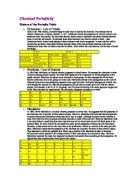Although Newlands was the first to realise that there was a significant pattern in the elements when they were arranged in order of increasing atomic mass, much of the credit actually goes to the Russian scientist Dimitri Mendeleev. What was significant about Mendeleevs work was that he predicted the properties of elements yet to be discovered in amazingly accurate detail, and allowed for these whilst drawing up his table. Proving his table worked, three of the elements he had allowed for were discovered within the next fifteen years. One such element was Gallium; known to Mendeleev as eka-aluminium [2] due to the similarities it had with aluminium, the element above it in Mendeleev’s Periodic Table.
Comparison between Mendeleev’s predictions for ‘eka-aluminium’ and gallium, the element occupying the same space in the Periodic Table [2].
“Table 1. Comparing Mendeleev’s predictions with the properties of element 31, gallium” From Article 1, Open book paper.
“The Modern Periodic Table” Fig 1, Article 1, Salters Chemistry Open Book Paper 2004. The modern Periodic Table is the result was a combination of many scientists’ work. Although it was invented by Mendeleev, it followed from ideas first proposed by Newlands and Dobereiner, and was revised by Mosely, who realised that it worked much better if the elements were arranged by atomic number as opposed to atomic weight.
The French scientist Paul Emile Lecoq de Boisbaudran discovered gallium in 1875, by a technique known as atomic emission spectroscopy. This uses an electric arc to excite atoms. The excited atoms then emit light and a prism is used to split this so that the emission spectrum for the sample is shown. The atoms absorb photons of radiation and use this to promote electrons to higher energy levels. The energy level can be described as quantised, that is; fixed quantities of energy are absorbed or emitted when electrons move between different energy levels. As each element has a different electronic structure, each element therefore also has its own unique emission and absorption spectra. When de Boisbaudran found a new, unique, set of emission spectra it was obvious that he had discovered a new element.
Chemistry (Salters) Insert 2, Skills for Chemistry, Article 1 Fig. 4, “The atomic emission spectrum of a pure sample of gallium” The emission spectrum shows the different frequencies of light emitted by gallium when subjected to atomic emission spectroscopy.
Gallium, known as eka-aluminium to Mendeleev prior to its discovery, has a number of unusual properties. Its melting point, 29.78°C, is such that it is liquid at room temperature in warm countries, yet solid at room temperature in others. Juxtaposing its low meting point, it has a rather high boiling point, at 2403°C, it has a liquid range of approximately 2373°C, greater than any other element. Like water, gallium is unusual in that it is denser in its liquid state than in its solid, presumably for the same reason, that the structure of the solid is more open than that of the liquid.
Gallium obviously shares many of its chemical properties with aluminium, the element above it in the Periodic Table, and after which it was originally named. Without a doubt it is this that enabled Mendeleev to predict its properties with the astounding detail and accuracy as shown in Table 1 (above). Gallium shares with aluminium the property of dissolving in both acids and alkalis, evolving hydrogen. This is a property specific to only a few of the metallic elements, all of which have amphoteric hydroxides.
Reaction of gallium with hydrogen ions [2]
2Ga(s) + 6H+(aq) → 2Ga3+(aq) + 3H2(g)
Reaction of gallium with hydroxide ions [2]
2Ga(s) + 2OH-(aq) + 6H2O(l) → 2[Ga(OH)4]-(aq) + 3H2(g)
Like many other metals, gallium is metal in appearance; it is a beautiful silver-white colour [3]. Gallium is slightly soluble in mercury, one of the other two liquid elements [3].
Although many of the elements have already been discovered, the search for new elements goes on. Using techniques such as atomic emission spectroscopy, as described above in relation to de Boisbaudran and his discovery of gallium, and an invention known as the UNILAC accelerator, scientists are able to synthesise and detect new elements. Increasingly, more and more developments in the world of chemistry are adding to our bank of knowledge concerning atoms, their structure and the ways they behave. It is necessary to have a comprehensive knowledge of these things, in conjunction with a great deal of ingenuity and luck in order to be able to make new and exciting discoveries. Using the (incorrect) theory that atoms are the smallest particles of matter, such techniques, as emission spectroscopy would never have been developed, as this requires complex knowledge of sub-atomic particles and their behaviour when energised. Quantum theory is very important in the development of the Periodic Table as it explains the structure of the atom and the movements and energies of particles on an atomic scale, which is very different to the rules of physics governing the macro world we experience on a day to day basis. Modern chemists have moved from merely discovering elements to creating them. In order to do this; the UNILAC accelerator is required. A beam of heavy ions are fired at a sample of a heavy yet stable element, lead is a common choice.
Bibliography
[1] “Chemical Periodicity, History of the Periodic Table”,
[2] “Gallium, a landmark in the history of chemistry”, Gordon Woods, Salters Chemistry Open Book Paper, 2004
[3] ESPI
Koran Adina McAuliffe Page







